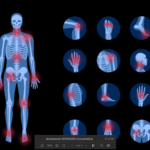Antimalarials may be used if a patient is experiencing too many flares. “Rarely, other [disease-modifying anti-rheumatic drugs], such as methotrexate, are needed,” says Dr. Pope, who is also an author of the recent study.
The Study
Dr. Pope and colleagues used data from the Canadian Early Arthritis Cohort (CATCH). This study includes more than 3,000 patients from several Canadian sites with early RA. In the final analysis, the researchers looked at a cohort of 154 patients enrolled in CATCH between April 2017 and March 2018. At enrollment, participants had experienced between six weeks and 12 months of persistent synovitis.
The researchers surveyed the patients about their history of joint symptoms prior to RA diagnosis. They also assessed other features, such as ACPA and RF serology, measures of disease activity and medical comorbidities. They used descriptive, chi-square and t-tests to compare preexisting characteristics of patients with and without a patient-reported history of palindromic rheumatism. Physician assessments necessary for formal diagnosis of palindromic rheumatism were not available.
Results: “Approximately 40% of patients with early [RA] said they started with swelling that came and went,” says Dr. Pope. “This rate seemed high, but it was comparable to some studies in the literature.”
Dr. Pope was careful to note this finding does not necessarily mean all patients with previous joint swelling experienced palindromic rheumatism as a clinician would define it. Because the classification relied on patient reporting, some cases may have been misclassified.
“Those with palindromic rheumatism in the cohort were often female and more likely to be RF positive, as would be supported by the literature,” says Dr. Pope. “They also had less swollen joints when they were diagnosed with [RA].”
Dr. Pope suggests this latter finding may be accounted for in different ways. She notes seropositive patients do not need to have as many swollen joints to meet RA criteria compared with seronegative ones. So seropositive patients may receive their diagnosis at a less advanced disease stage. It may also be that patients with palindromic rheumatism come to medical attention more quickly and are, therefore, diagnosed earlier. It’s also possible the disease course is somewhat different in patients who display symptoms of palindromic rheumatism prior to developing RA.
The study also found patients with prior palindromic rheumatism were more likely to have comorbidities, such as back or spine arthritis. Dr. Pope says this unexpected finding would need verification and follow-up for interpretation.


